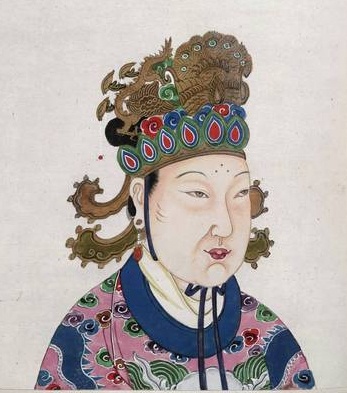
Image from An 18th century album of portraits of 86 emperors of China, with Chinese historical notes. British Library.
Empress Wu Zetian went from concubine to the only female ruling Empress of China in seventh century C.E.
Unusually, Wu Zetian’s father encouraged his daughter to learn to pursue an education. She learned to read and write. She also learnt to play music, write poetry, and speak publicly. She was also reportedly very beautiful. At age fourteen, she was selected to become the concubine of Emperor Taizong. He called her Mei-Nang, meaning beautiful girl. She was first put in charge of the royal laundry, but after Taizong discovered her intellect, he made her his secretary.
During her years as concubine and secretary, she caught the eye of Taizong’s son and successor, Li Zhi. When Emperor Taizong died, all his concubines had their heads shaved and were sent to religious seclusion to become nuns. Li Zhi was so in love with Wu Zetian that when he became Emperor (under the name Gaozong) he returned her to court, first as his concubine and then his wife. Emperor Gaozong already had a wife, Lady Wang, and first concubine, Lady Xiao, who were very jealous of Wu Zetian. Lady Wang’s nephew was already chosen as successor.
Wu Zetian gave birth to two sons and a daughter. Her daughter was murdered in her crib at a young age. Wu Zetian accused Lady Wang of the murder, who was the last in the room and had no alibi. She also accused Lady Wang and her mother, along with Lady Xiao, of witchcraft. Emperor Gaozong divorced Lady Wang and all three women were exiled. Lady Wang’s nephew was removed as successor, and Wu Zetian became Gaozong’s wife, and her sons became his heirs.
Behind closed doors, Wu Zetian was the real power during her husband’s rule. She challenged the traditional rule of men, undertaking activities normally reserved for men only. Her military campaigns reduced Korea to a vassal state in 668 C.E.
Emperor Gaozong died in 683 C.E. and her son took the throne. He and his wife, Lady Wei, did not cooperate with Wu Zetian and took power of their own. Wu Zetian had her son and wife charged with treason and exiled. Her second son now took the throne, and Wu Zeitian kept him safely under house arrest. However, he still managed to disappoint his mother and he was forced to abdicate in 690 C.E. This time Wu Zetian proclaimed herself Empress and ruled outright.
Now that she was Empress, Wu Zetian changed the name of the dynasty from Tang to Zhou. This affectively reset history. She also proclaimed herself a reincarnation of the Maitreya Buddha. Her name was Empress Shengsen, Holy Spirit. During her reign she imprisoned the royal family, organised secret police and a spy network, and had deity sculptures built in her likeness.
No area of Chinese life was left untouched by Wu Zetian. From writing to education to farming, Empress Shengsen revolutionized China. Her legacy continued after her death, as her son’s wife and her daughter became powerful female powers behind the throne. Under the reigns of her successors, China enjoyed some of its most prosperous times.
